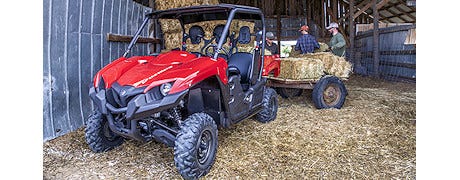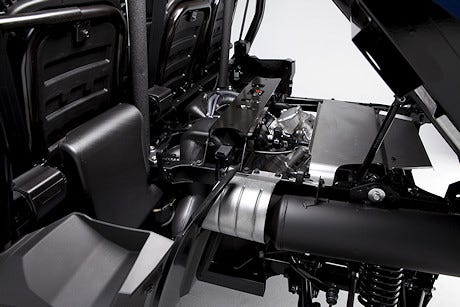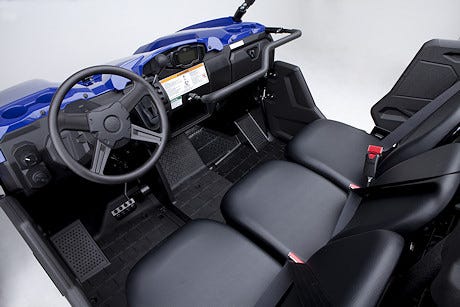
The power, comfort and fine handling of Yamaha's new Viking side-by-side utility vehicles should capture a sizeable piece of the rising UTV market.
The side-by-side market appears to be the fastest-growing segment of the overall ATV-UTV-motorsports market and half of it is farmers and ranchers. Yamaha says the average buyer in this market has ATV experience but is typically buying his first side-by-side, or "Utility Terrain Vehicle." The company wants as much of that as it can get and designed the Viking to enter that fray.

HARD AT WORK: Yamaha's new Viking side-by-side proved itself tough, fast and comfortable during test drives by Farm Progress editor Alan Newport on a Wyoming ranch.
We took the Viking for a daylong drive in early September on the Red Reflet Ranch in central Wyoming during corporate Yamaha's official introduction to journalists. The Red Reflet is a working cattle and horse ranch which doubles as a high-end guest ranch. The 27,000 acres has a variety of terrain, from rough mountainsides at 8,500 feet elevation down to smooth gravel roads and irrigated alfalfa fields in the valley at just under 5,000 feet.
The Yamaha engineers, marketers and test riders clearly put a lot of thought and time into designing this new machine. It handled everything we drove it over, including some high-speed travel on rough trails. From that experience, I'd say it has the ability to get you just about anywhere fast to do most anything you need to do.

ENGINE MOUNT: The engine for the new Viking is low and underneath the steel dump bed, which helps keep heat and engine noise out of the cab.
Yamaha testing supervisor Pat Biolosi says the Viking was designed from the start to provide a balance between work capabilities and good off-road handling. We found this to be true as the Viking has ample power for pulling and hill-climbing, good comfort and enough room in the three-seat cab. Yet it retains the good ride and all-speed handling and ground-hugging ability of their earlier side-by-side, the Rhino.
The new Viking is about 10 inches wider than the old Rhino and has a longer wheelbase, too. I was a fan of the Rhino for its handling, power and agility but I readily admit it was a little prone to tipping over and it always felt to me a little crowded in the cab.
The Viking overcomes all that with its wider stance and its roomy cab. Yamaha says the Viking is "the only true 3-person" UTV and it sports three bucket seats with head rests mounted up on the roll-cage frame. The back of the middle seat is reclined about 5% behind the driver and passenger seats to help provide more shoulder room. Still, it's easy to slide all the way across the three seats and out the other side if momma cow goes on the offensive.
The seating and position of the steering wheel feels a bit more car-like than some competitors, which I found pleasant.

ROOMY CAB: Plenty of room in the cab for two or three adults, with the nice addition of an ergonomically designed grab bar for both passengers and non-slip floorboards which seem just about right.
The extra room in the Viking's cab was made available by moving the engine down and back significantly from where it sat in the Rhino. That also moves engine heat and noise out of the cab. And don't let my comparisons of the Viking with the old Rhino suggest to you the Viking is just an upgrade. It is redesigned from the frame up. It still uses Yamaha's tried-and-true 686cc, single-jug fuel-injected and liquid-cooled engine as did the Rhino and as still does the Grizzly 700 ATV. However that power plant in the Viking cranks out significantly more horsepower at the rear wheels than previous versions, thanks to several design improvements.
The Viking retains Yamaha's excellent dual-drive transmission system which the company calls the Ultramatic. It combines an oil-bath centrifugal clutch inside the crankshaft case with a full-time engagement V-belt torque converter. This system reduces wear on the V-belt because the centrifugal clutch takes all the abuse of initial engagement into and out of drive gears instead of the belt slipping back and forth between engaged and disengaged between the converter sheaves on the torque converter.
~~~PAGE_BREAK_HERE~~~
A dash-mounted knob controls all changes from two-wheel-drive to four-wheel-drive to full differential-lock operation.
I also found the Viking's engine braking so outstanding I rarely used the four-wheel disk brakes, even on steep downhill treks. When I did apply the brakes, even at high speed on gravelly surfaces, they seemed to grab nicely but not lock up.
At 600 pounds payload rating the Yamaha isn't as highly rated as some of its counterparts but Yamaha says that's essentially an academic comparison, since other UTVs they've tested didn't handle their rated 1,000 pound payloads well at all. They also noted their research says 600 pounds is about the limit most farmers and ranchers tend to put in a UTV before they switch to a pickup truck.
The electronic power steering always seemed just right, even on the worst trails at the highest speeds: Neither too much steering nor too little. Yamaha claims the Viking's steering is "precise and predictable." I say that's an accurate description.
A black, polypropylene sunbonnet is standard atop the roll cages of all but the blue-colored Vikings.
The Viking sports a lot of other niceties that seem worth mentioning, including these:
Ground clearance of almost 12 inches.
Towing capacity of 1,500 pounds.
Full underbody skid plate.
Steel dump bed with four steel tie-downs.
Very low vibration at all rpms above idle.
Four-wheel independent suspension with eight inches of travel.
Dash-mounted emergency brake which actuates a disk in middle of the rear axle.
Easy access to the radiator and battery under the removable, triangular front hood.
Without power steering the Viking has an MSRP of $11,499. With EPS it lists for $12,499.
About the Author(s)
You May Also Like




